I´m trying to create a 2d map with a player (filled circle) and I´m starting to create a raycasting. Before doing the raycast I´m trying to draw a simple FOV (field of view) which should be an arc fillid with a solid red, like this:
(The image is just to give an idea of the filled solid red arc)
To calculate the arc for the drawing I get the first position of the arc with this:
rayAngle = rotationAngle - (FOV_ANGLE /2)
The rotationAngle is the start position of the player in radian:
90d - PI/2
270d = 3 * PI/2
180d = PI
360d = 2 * PI
The FOV_ANGLE is 60d in radian, which I did with this function:
60 * (PI /180)
And for the others rays I use these calc:
ray_angle += fov_angle / num_ray;
The num_ray is just the width of the windows, consider in this case that it is (11 * 32)
With this func. I calculate each ray and save in an array
t_point *rays
For the struct t_point I have this:
typedef struct s_point
{
int x;
int y;
int color;
} t_point;
After that I get each index of the array and draw a line using an dda algorithm:
#define ROUND(a) ((int)(a + 0.5))
void ft_line_dda(t_data *img, t_point start, t_point end)
{
int dx = end.x - start.x;
int dy = end.y - start.y;
int steps;
int k;
long double xincrement;
long double yincrement;
long double x = start.x;
long double y = start.y;
if (abs(dx) > abs(dy))
steps = abs(dx);
else
steps = abs(dy);
xincrement = abs(dx) / (long double)steps;
yincrement = abs(dy) / (long double)steps;
my_mlx_pixel_put(img, ROUND(x), ROUND(y), get_color(ft_create_point(ROUND(x), ROUND(y), 0), start, end));
for (k = 0; k < steps; k++)
{
if (start.x <= end.x)
x += xincrement;
else
x -= xincrement;
if (start.y <= end.y)
y += yincrement;
else
y -= yincrement;
// my_mlx_pixel_put(img, ROUND(x), ROUND(y), start.color);
my_mlx_pixel_put(img, ROUND(x), ROUND(y), get_color(ft_create_point(ROUND(x), ROUND(y), 0), start, end));
}
}
But the problem is that I keep getting this image, with some dots and spaces:
(The size is ok. The problem are the empty space and dots)
Please find bellow the code related to the arc (pseudo-raycasting) I´m trying to do:
void ft_create_rays(t_vars *vars)
{
long double fov_angle;
long double ray_angle;
long double num_ray;
t_point *rays;
int i;
i = 0;
fov_angle = ft_degtorad(FOV_ANGLE);
num_ray = vars->win_width / WALL_STRIP_WIDTH;
ray_angle = vars->player->rotation_angle - (fov_angle / 2);
rays = malloc(num_ray * sizeof(t_point));
while (i < num_ray)
{
rays[i] = ft_create_point(vars->player->x + cos(ray_angle) * 100,
vars->player->y + sin(ray_angle) * 100, 0x00ff0000);
ray_angle += fov_angle / num_ray;
i++;
}
if (vars->rays != NULL)
free(vars->rays);
vars->rays = rays;
}
void ft_raycast_render(t_vars *vars, t_data *img)
{
int i;
t_point central;
i = 0;
central = ft_create_point(vars->player->x, vars->player->y, 0x00ff0000);
while (i < (vars->win_width / WALL_STRIP_WIDTH))
{
ft_line_dda(img, central, vars->rays[i]);
i++;
}
}
void ft_raycast(t_vars *vars, t_data *img)
{
ft_create_rays(vars);
ft_raycast_render(vars, img);
}
I think I showed all the code that is need to help me debug this. Anyway I will let the link to the github repository:
https://github.com/wblech/cub3d
P.S. I think the problem might be that the end point is in the wrong place and the line go to a different position. But I don´t know if is this and if it is I don´t know how to fix.

